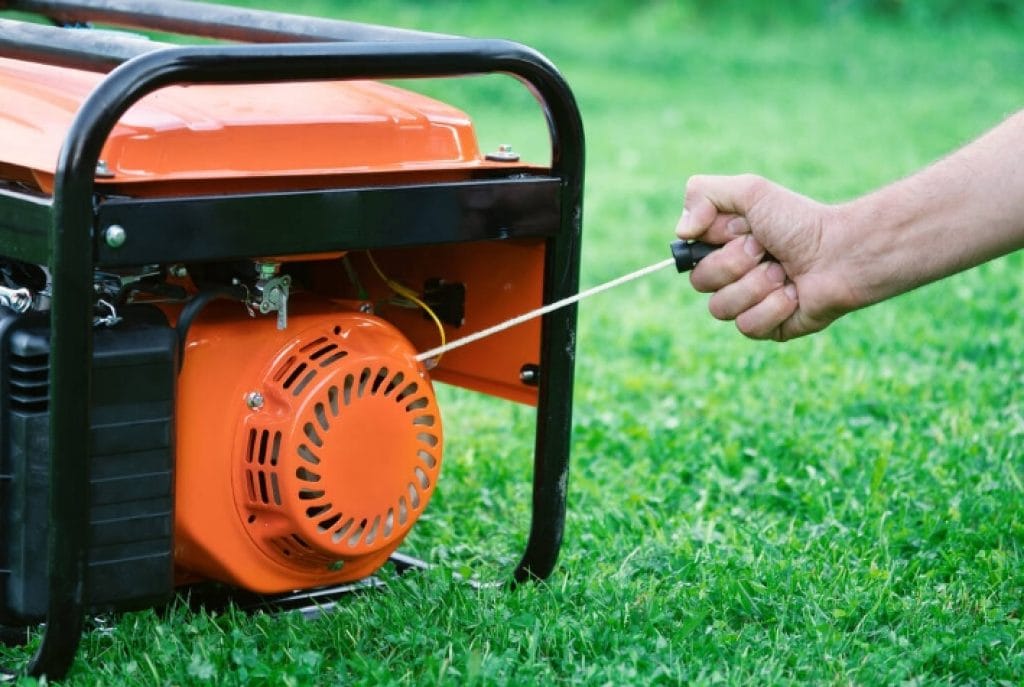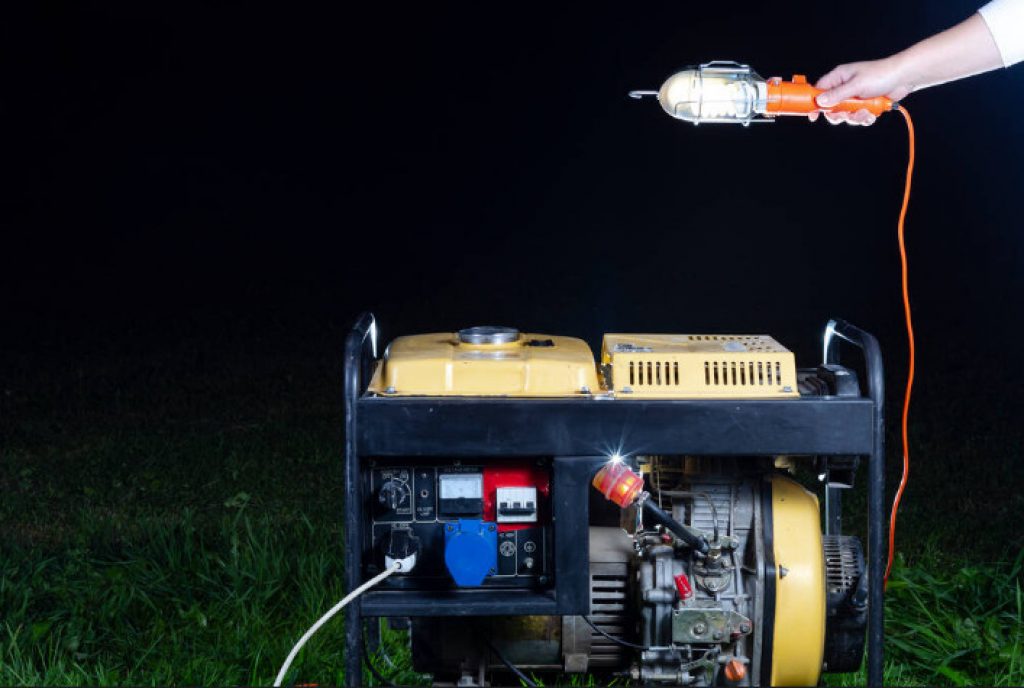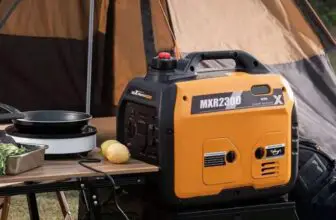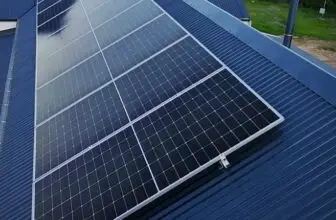
Generators are useful as backup power sources during power outages. Many businesses, worksites, and hospitals use generators to keep their critical system running through blackouts. Smaller generators are widely used in regular houses too, during climate emergencies and man-made disruptions of the grid as well as for outside works, carpentry workshops, etc. If you work from home or if you use life-support equipment, a power generator makes sure you always have a power source and avoid disruptions. So, how does a generator work?
An electrical generator or simply a generator doesn’t really produce electricity. It converts mechanical energy into electricity through electromagnetic induction: an electrical current is produced in a conductor when it moves through a magnetic field. All modern generators are electromagnetic generators, which use an engine, an alternator, and fuel to work.
So why should you understand how generators produce electricity? It can help you effectively identify your personal needs and decide what kind of electrical generator you need, and what kind of maintenance and fixing it might require.
Guide on Electromagnetic Generators
Contents
Before choosing an electrical generator and deciding what you need, it’s important to understand what is a generator. Simply put, it’s a machine that can make electricity even when the power lines are cut. How do generators produce electricity? Because they run on the principle of electromagnetism, it requires fuel, proper cooling, and maintenance. Its power and energy source should be chosen based on your needs, otherwise, you risk overloading it and causing it to fail.
Main components of a generator
Generators can be big enough to power worksites and hospitals and small enough to power a light on a bicycle, but the main parts of a generator are the same in all models.
- Engine
It supplies mechanical energy to the generator, no matter what fuel it runs on. The amount of energy depends on the size of an engine — the bigger the engine, the more energy you get. The engine determines how generators work, and what power load they can handle.
- Fuel system
The engine uses fuel as the external source of mechanical energy. All generators come with an external fuel tank, which can be connected by tubes to the generator. A variety of fuel types can be used: diesel, gasoline, propane, or even natural energy.
- Cooling and Exhaust Systems
As an engine works it gets hot, so it needs a cooling system that prevents its overheating, usually by using cooling liquids that absorb the heat and run it through ventilation systems. Exhaust systems aim to discharge the gasses away from the engine and people, which is why electrical generators shouldn’t be operated inside houses and garages, even when the doors are opened.
- Lubrication System
Because the generator is made of small parts which constantly move against each other, they need to interact smoothly. Engine oil is used to lubricate them, and it also protects all the parts of the generator from extensive wear.
- Alternator
The engine generates mechanical energy from fuel and the alternator transforms it into electricity. It has stationary parts and moving parts, which create a magnetic field that creates an electric current.
- Voltage Regulator
Once the current is produced the generator regulates the voltage. It converts AC current into AC voltage and helps to maintain the optimal voltage level while the generator operates.
- Battery Charger
To start work generators need a battery, just like a car. The battery can be charged either by the generator itself while it’s running or it can be charged separately.
- Control Panel
This is a place where you can operate the generator and adjust every part of the process, from start to shut down.
- Main Assembly / Frame
Its main function is to hold the generator in one place, with various options available if you want it waterproof or if you want to store it outside. The other function of the main assembly is the grounding of the generator’s electrical parts.
So the main parts of a generator which produce electricity are the engine, alternator, and fuel, while other parts like a voltage regulator, lubricating system, battery, and exhaust system are needed to make the generator safe and to keep it running smoothly.
How do generators produce electricity?
Simply put, the process of producing electricity looks like this:
- The engine uses fuel (gasoline, gas, natural energy, etc.) to create mechanical energy via moving electrons.
- An alternator of electromagnetic generators has a copper coil that acts as a conductor. It rotates rapidly between the poles of a magnet.
- This movement creates electrical charges which are then directed into the wiring which makes a flow of currents.
- The current is converted to an output of AC voltage, which is maintained at an optimal level
- The generator then supplies this electrical current to appliances, tools, and electrical systems of the building.
So, contrary to its name, an electrical generator doesn’t generate anything, rather it converts one type of energy to another one while acting as an electromagnet. Understanding how electric generators work helps to understand the main features that you will see in product descriptions, as well as to understand what you will need from an electrical generator.
Features of the generators
We found out what is a generator and how generators work. Now let’s take a look at the features it has and what is important when you choose a generator to suit your needs. In order to use the generator safely, you need to understand what exactly you require it for and plan what you will power with it.
- Power
There are ranges of electrical generators with all kinds of power outputs. Making a list of things that you are planning to power will help you understand what wattage (companies use W to determine the output of the generator) you’ll need. If you plan to power lightbulbs and some electrical appliances in your house, like air conditioning and an electric stove, you might need different wattage than if you were to power an electric drill or a saw in a carpentry workshop.
The rule of the bigger the generator, the more energy it provides still applies, so understanding your maximum intended use is important. Your generator should be producing more power than the electrical devices you connect to the generator will draw. Otherwise, you risk overheating and overpowering the generator, causing it to fail.
Smaller generators are usually enough to power basic home appliances for a short amount of time.
Bigger ones are made to power entire electrical systems of homes, offices, and hospitals and last for several days.
- Portability
Electrical generators can be portable and stationary (standby). Portable generators are often used in trailers, construction sites, camping trips, etc. They are small, easy to move and transport. They provide a limited amount of power, between 500W to 17.5kW, which is enough to provide light and keep essential appliances like air conditioners running.
Most of them are powered by gasoline, diesel, bio-diesel, propane, or natural gas, and because of how generators work most of them are air-cooled and discharge exhaust fumes. It means you’ll have to use them outside and provide protection from rain/snow.
While nowadays there are portable generators that are able to handle longer work hours and higher outputs, they are still designed for a limited amount of time. Hours, not days.
Standby generators are used for the majority of businesses, hospitals, critical infrastructure facilities, and many homes as well. Trying to power an entire house with a portable electromagnetic generator can cause it to overload and overheat, posing a great risk of fire.
They are able to support very high power requirements: from 3kW to several hundreds of kilowatts, for extended periods of time.
How do electric generators work in big buildings to support critical systems almost instantly after a blackout? It happens because of the uninterrupted power supply (UPS). Basically, a generator is hard-wired into the main distribution panel and can be started manually or automatically in just 10 to 30 seconds. This ensures that there are no long breaks in the power supply, which can be crucial to those, who rely on life-support medical equipment at home, or who work from home and need to eliminate the possibility of outages.
- Fuel
Most commonly, the electromagnetic generator uses diesel, natural gas, gasoline, and propane. You should take into account what type of fuel you are planning to use, and if you cannot decide for yourself —consult a utility company or experienced electrician who can advise you on the type of generator that will suit your needs.
Using fossil fuels also requires specific safety measures, such as carbon monoxide poisoning prevention. Even if you cannot smell it, you can be inhaling carbon monoxide, so if you experience dizziness and weakness and start to feel sick due to the generator — get fresh air right away and/or seek medical help. It is also recommended to install battery-operated carbon monoxide alarms to ensure your safety when using generators.
It is prohibited to use portable generators indoors, including your house, garage, sheds, and crawlspaces, even if the doors and windows are opened.
Nowadays there are many options for using renewable energy generators like photovoltaic systems (PV) or solar panel systems. Those can be portable, useful for things like camping, or permanently installed on the rooftop of the house.
Other renewable energy options include wind turbines, water turbines, and natural gas. Those might be a good idea for homes and businesses that are seeking to lower their carbon footprint.
- Noise
As with any engine, noise is an important factor to take into account when you’re looking for a generator. If possible, look for generators with noise reduction technology to reduce noise pollution.
If you already own a generator, but it doesn’t have this feature, you could purchase a removable generator silencer or muffler.
What maintenance does an electrical generator need?
Purchasing and installing a generator is only a start. Just like a car, they require regular maintenance to keep them running smoothly and safely.
Depending on the type of fuel you use (gas, diesel, etc.) you will need to take various steps to ensure it runs smoothly.
That includes regular checks of the parts of a generator that keep it running: Lubricating system, Cooling, and Exhaust systems, oil levels, and starting system. As well as regular inspections of piping and hoses for leaks, holes and other signs of wear.
Another important point is regular checks of the batteries that are used to start the generator. Weak, undercharged batteries are a common problem in starting the generator. To avoid hitches in how generators work starting batteries should be well-maintained and regularly checked and cleaned.
Standby generators in your household or business should have a checklist of weekly and monthly checks, to verify you have adequate fuel levels, no leaks, adequate battery levels, and timely change of the oil.
Annually and bi-annually you should schedule a maintenance check with a certified technician who will check how it works and identify any issues that could be there.
Understanding your requirements
Many households and businesses use an electrical generator in times of power outages and blackouts, which is effective as an emergency precaution.
However, many people who live in remote areas, with no access to the grid, rely on electromagnetic generators as a main source of power.
In those cases, you should thoroughly inspect the amount of output you might require, and what systems will be fuel-efficient for you. How do generators work with weather conditions in your area, and whether opting for a solar, wind, or water turbine option might be a better cost-efficient option for you?
In remote areas running out of fuel can be a potential problem, so making sure your generator is supplied with the necessary fuel is important. However, if you are storing large amounts of fuel, make sure to take fire-hazard precautions.
FAQ About Electromagnetic Generators
Knowing how generators work can not only help you choose one and identify your needs, but it could also answer some of the basic questions of their maintenance, such as where to store it and what to use or not use with them.
Here are some of the most common questions people have besides how generators produce electricity.
- How does a generator work without electricity?
The generator uses fuel to produce energy, however, it needs something to start the process. There are specific parts of a generator that are used to do just that: batteries, that charge while it works or in a separate outlet, or, in smaller portable generators, a push button or a pull cord.
- Can you run a generator in the rain?
Manufacturers prohibit consumers to use portable generators in rainy or wet conditions. Instructions say that for the safe use of an electric generator it should be operated on a dry surface under an open, canopy-like structure and should only be touched with dry hands.
- How long do generators last?
This fully depends on the type of electrical generator you are using.
Portable generators can power separate appliances or light sources for several hours, usually maximum of 12, while stationary generators can support high-power buildings and households for several days if used and re-fueled correctly.
- What happens if you overload a generator?
Because of how generators work they produce heat and require adequate cooling and air-cooling systems. If you incorrectly use your generator to power more appliances than it could take, it leads to overheating and overloading, which in turn creates a fire hazard.
- How expensive is an electrical generator?
Portable generators are very common because they are cheaper and easier to install and use. Depending on the amount of power you might need, a portable generator can be anywhere between $600 and $2,500, with most homeowners paying about $1,200 for a 5,500-watt gas-powered model.
A standby generator is significantly more expensive, but it is also able to power your entire household for extended periods of time. Depending on the wattage, the cost of standby electromagnetic generators varies from $2,000 to $20,000, not including the costs of installation and maintenance.
- What safety measures should I take with a portable electrical generator?
OSHA lists these as the main health hazards connected with using portable generators:
- Shocks and electrocution from improper use of power or accidentally energizing other electrical systems.
- Carbon monoxide from a generator’s exhaust.
- Fires from improperly refueling a generator or inappropriately storing the fuel for a generator.
- Noise and vibration hazards.
Using proper storage and following the rules listed by the manufacturer should minimize the risks to your health and safety. You should also always contact a qualified electrician for connecting a generator to the electrical system of your house/building/office.
What Generator Works for You?
Why should you know how electric generators work and how generators produce electricity? It can answer any questions you might have about what type you will require and what maintenance it will need.
The next step should be deciding what exactly you need it for. When it comes to the cost of generators, it might seem like a large investment to install a standby electrical generator. But when you take into account that it would be able to power your entire house for a long time in case of emergencies, this might be a sound investment. If your needs are smaller a cheaper portable version might do perfectly well.










